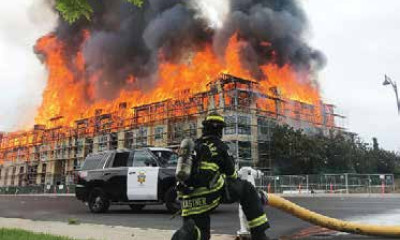A Private Adjuster's Perspective: Fire Devastation Reaches Far Beyond Physical Property
 Fire Devastation Reaches Far Beyond Physical Property
Fire Devastation Reaches Far Beyond Physical Property
Early one Saturday morning, a fire suddenly erupted, completely engulfing the Dillon Humane Society in Dillon, California. The building and contents were destroyed beyond recognition. Sadly, and even more devastating, was the loss of animal life including that of two pets scheduled to be picked up by their forever family the following day.
On the Friday before the fire, Mr. and Mrs. Jones and their two children toured the Dillon facility, fell madly in love with Bow Wow and Meow, signed adoption papers, and scheduled to pick up, on the Monday next, these new family members.
Dillon had a commercial insurance policy covering the losses to its building and business personal property as well as its projected income loss. The Greenspan Co./Adjusters International (Greenspan/AI) was retained to represent Dillon in the documentation, measurement, presentation, and negotiation of the claims.
After sifting through the rubble and preparing a game plan for the filing of claims for the clearly compensable losses, Greenspan/AI’s attention was then drawn to the painful question:
What about payment for the two pets scheduled to be go to their forever home?
This question posed two issues: 1) were the animals personal property; and, if so, 2) was the loss covered under Dillon’s policy?
The answer to the first question was clearly yes.
The answer to the second question was clearly: it depends.
Question 1: Were the Pets Personal Property?
It is almost universally recognized, throughout the United States, that domesticated animals, despite their loving nature and “family stature,” are personal property subject to ownership the same as inanimate objects.
Over 130 years ago, the California Supreme Court pronounced:
“Dogs are property….” (Johnson v. McConnell, 80 Cal. 545 (HN2), 22 P. 219, 1889)
Even before the California Supreme Court made such a blunt and unambiguous declaration, California codified this common law principle:
“Property defined”
The ownership of a thing is the right of one or more persons to possess and use it to the exclusion of others. In this code, the thing over which there may be ownership is called property.” (Civil Code Section 654)
“In what property may exist”
There may be ownership of all inanimate things which are capable of appropriation or of manual delivery; of all domestic animals….” (Civil Code Section 655; emphasis mine)
Clearly, according to California law, domesticated animals are property.
To close the loop, one must ask: are dogs and cats domesticated animals?
“Domesticated animals are animals that have been selectively bred and genetically adapted over generations to live alongside humans. … Animal domestication falls into three main groupings: domestication for companionship (dogs and cats); animals farmed for food (sheep, cows, pigs, turkeys, etc.), and working or draft animals (horses, donkeys, camels)” (National Geographic, Natasha Daly, 2019).
Thus, it is clear that dogs and cats are domesticated animals and, therefore, personal property.
Question 2: Was the Loss of the Animals Covered Under Dillon’s Policy?
The answer to this question is a resounding: IT DEPENDS. On what does it depend? It depends on the actual language of Dillon’s policy.
But aren’t all commercial business policies the same? No! Let’s look at a few.
Example 1
- Property Not Covered
Covered Property does not include:
...
b. Animals, unless owned by others and boarded by you, or if owned by you, only as ‘stock’ while inside of buildings.” (Insurance Services Office, inc. Form CP 00 10 10 12; page 12 of 16).
Example 2
- Property Not Covered
...
3. Animals - ‘We’ do not cover animals…unless owned by others and boarded by ‘you’. ‘We’ do cover animals ‘you’ own and hold for sale.” (American Association of Insurance Services Form A)
Example 3
- Property Not Covered
...
2. Animals—‘We’ do not cover loss to animals…except death or destruction of animals held for sale caused by ‘specified perils’ or breakage of building glass.” (American Association of Insurance Services Form B)
Example 4
- Property and Costs Not Covered
...
9. Live animals….” (Company A).
And, finally, Example 5
- Property Not Covered
We do not cover losses to:
A. Animals; ….(Company B).
Turning back to our question: “Was the loss of Bow Wow and Meow covered under Dillon’s policy?”
The answer still remains a resounding: IT DEPENDS.
It depends on which policy form was in play and the actual facts and circumstances surrounding the tragic loss.
ISO FORM:
This form appears to cover the loss of animals if owned by others and boarded or if stock while inside of buildings.
In this situation, Mr. and Mrs. Jones purchased and, therefore, owned-Bow Wow and Meow the day before the fire. Dillon was boarding them over the weekend. Thus, it would appear that coverage would attach.
Assume the Friday visitation was just a look-see and that the decision to purchase was going to be delayed until after the weekend. In this case, if Bow Wow and Meow (Dillon’s stock) were destroyed while “inside” the building-- and not in an outside run or kennel-- coverage would also, most likely, be provided.
AAIS FORM A:
It would appear that, under this form, coverage would apply for the same reasons as those discussed under the ISO Form above. However, there is one notable difference: this form does not require Bow Wow and/or Meow to be “inside” the building at the time of their demise. It only requires that Dillon own them and hold them for sale.
AAIS FORM B:
Under this form, Dillon will have the unhappy duty of acting as a “coroner” investigating the cause of Bow Wow and Meow’s deaths. Coverage is only going to be afforded if Dillon can prove that its animals succumbed to the peril of fire (one of the specified perils in the form) or the breakage of glass.
Company A:
Here, I am not sure whether the intent of the form is to deny coverage to animals who remain alive after suffering injury, but pay the value of those animals who perished in the event, or just to provide coverage for already dead animals such as those found in a taxidermist’s facility.
To the extent that this form is ambiguous, the rules and presumptions favor coverage.
Company B:
This appears to be the clearest of all the forms. Animals are just not covered property. It should not matter whether: dead or alive, stock, inside or outside of buildings, boarded, or damaged or destroyed by a specified peril.
Conclusions:
Several conclusions can be drawn from our discussion at hand:
- The actual policy language is of utmost importance.
- Likewise, the actual facts and circumstances of the loss are of utmost importance.
- One should understand the nature of the business to be insured and the various policy forms available from which an insured can choose.
- READ THE POLICY both before (i.e. upon receipt) and after an actual loss.
In the actual Dillon situation, because of an ambiguity in the policy, Greenspan/AI was able to obtain coverage, by arguing that the benefit of doubt inures to the insured, and compensation for the loss of the pets. In a future article, the value of loss as it relates to animals will be discussed.







